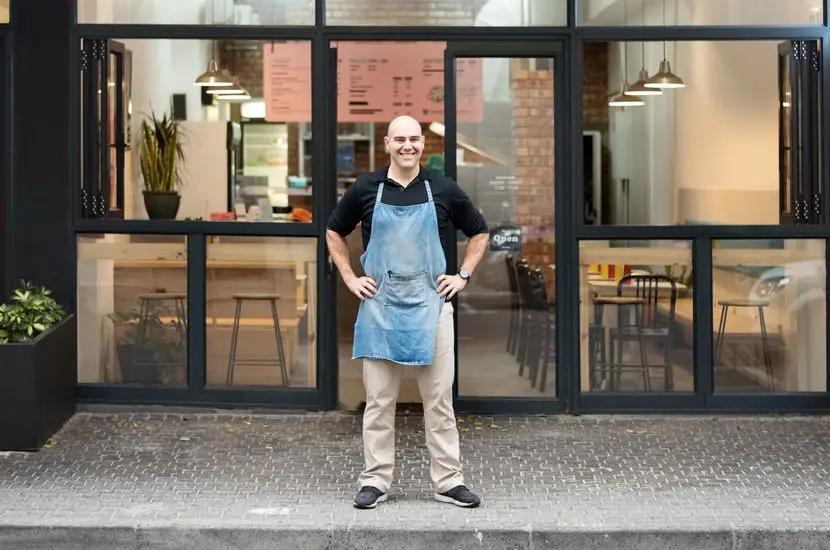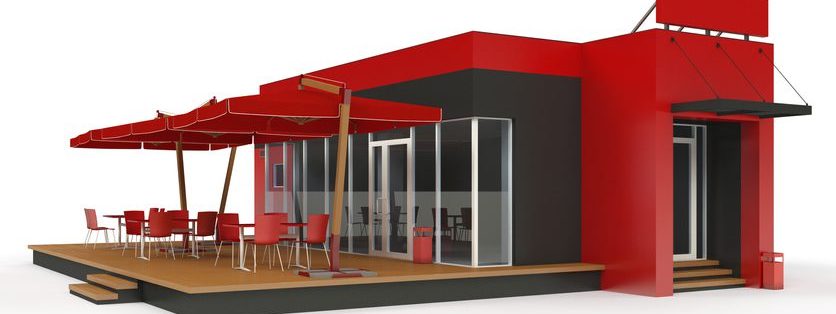
American consumers have a seemingly endless appetite for new fast food brands. Entrepreneurial quick service restaurants with a unique niche, including new regional and ethnic fast food startups, are coming on strong. Founders aspire to be the next Shake Shack or Habit Burger Grill, the Southern California company acquired by Yum! Brands in 2020.
There are few business models where “form follows function” so closely. Here’s what to keep in mind when planning your fast food restaurant interior design.
The pandemic permanently changed QSR design
In a little over a year, consumers have come to expect contactless order fulfillment from fast food restaurants. Increasingly, it appears this will be the new normal, as Covid lingers and continued social distancing is desired (or required).
As most of us know from first-hand experience, many restaurants were not prepared for the surge of demand for customer pickup, as well as the onslaught of third-party delivery pickups by the likes of DoorDash, GrubHub, and Uber Eats. Quick service restaurants struggled to manage the scrum.
New fast food brands have the opportunity to design features that established brands are trying to add in their Covid-driven retrofits.
Order pickup zones
An efficient new fast food restaurant design should offer a separate, easily accessed order collection area. Divert disruptive foot traffic to a separate area of the store with its own clearly signed entrance. This will prevent collection activities from interfering with in-store ordering as well as the dine-in experience.
Order kiosks
While not new, order kiosks have grown in popularity as people minimize face-to-face interactions. New fast-food concepts should ensure that kiosks are an obvious, appealing option for guests. Wendy’s has included kiosks in their Smart 2.0 store prototypes. The company discovered from customer feedback that restaurants with kiosk ordering as an option had higher satisfaction ratings than those without.
Walk-up order windows
Shake Shack has revived the walk-up window at eight of its locations. The simple yet practical customer interface is perfect for the customer who doesn’t want to dine in and may not order online (aka not a smartphone user). It’s also well-suited for locations where drive-through isn’t feasible.
Food lockers
Food lockers are another “new” method of contactless food delivery experiencing a surge in popularity. Burger King, KFC and Smashburger have added food lockers to their new store designs. Utilizing a touch screen, pinpad, or even text messaging and QR codes, the customer opens their locker and retrieves their food. Some lockers are chilled, others are hot; some utilize UV light to kill bacteria.
Lockers were considered by fast food brands prior to the pandemic, a strategy to increase service speed while lowering payroll expense. Dunkin explored the concept in 2018, seeking to accelerate service in its busiest locations. In 2019 Wingstop announced it planned to use lockers to cut labor costs, because 75% of its transactions were collection. Another pandemic-related benefit: food lockers can help companies weather the chronic labor shortages that have hit the food and beverage sector hard.
Digital menu boards
Digital menu boards are another way to intensify the customer/brand interface and even boost orders. Panera has implemented digital screens for drive-through and in-store menus. The screens, linked to the company’s loyalty program, display recent orders and favorite selections. Customers can place an order from their phones, regardless of whether they’re using rapid pickup, drive-through, delivery or even dine-in. They receive notifications on their phone when their order is ready.
Doubling down on drive-through
2020 was the year everyone learned to love drive-through, but even that format has undergone an evolution. Many new fast food restaurants now have double lane drive throughs. At Shake Shack’s “Shake Track”, one lane is for placing orders and another lane is for online order pickup, which facilitates more efficient service. Even Panera Bread has added fast food style double drive throughs to its new, streamlined, fast casual restaurants.
Years ago, Dutch Brothers drive-throughs began sending employees outside to take orders from customers idling in long lineups. This improvised workaround has become commonplace: fast food restaurants now dispatch employees with tablets to expedite ordering. New QSR designs should prioritize worker visibility and safety, and ensure ease of access between interior and exterior.
Dialing in dine-in
With all the emphasis on contactless collection, it might seem that dine-in is dwindling in importance. But fast food restaurants are now looking at dine-in as an opportunity to enhance the guest experience and tell their brand story. A customer who chooses to dine in, despite faster and more convenient options, is taking a break. They’re getting out of their own environment, and hoping to relax a bit. Another demographic taking advantage of dine-in is young people looking for a place to gather.
Even as Panera reduces the size of their new concept restaurants by 25%, the company is showcasing the core of their brand identity (baking fresh bread in-house) by making the interior of their ovens visible to diners. Wendy’s new interior design places sinks outside the restrooms, enabling guests to wash their hands without entering the restroom. The company believes this customer touchpoint subtly reinforces Wendy’s core value of “freshness”. Wendy’s interior design updates also include gas and electric fireplaces and faux wood flooring. Chick-fil-A is also upgrading its interiors with higher-end finishes.
In the McDonald’s redesign of 7000 US and UK restaurants, natural materials have replaced plastic finishes, and lighting is softer. There’s a new “linger” area with armchairs, sofas and Wi-Fi connections, as well as a solo diner zone with TVs that’s more like a bar, and a colorful “family zone” area offering flexible seating for different sized groups, with fabric cushions. As these trends take hold, the fast food design standard of allocating ten square feet per diner may evolve, too.
While QSR design doesn’t need to emulate an upscale restaurant—no customer comes to a fast food restaurant expecting gracious dining—the dine-in guest has made a conscious choice to spend time in the space, and well-designed interiors can reward that impulse with a richer experience.
Fast food restaurant interior design: It’s outside, too

Increasingly, a QSR interior is outside, too. Outdoor dining has become a comfort zone for customers who are reluctant to congregate indoors with others. Al fresco dining areas also make your restaurant more visible, especially if they include colorful umbrellas or awnings. In climates where outdoor dining is possible for most of the year, outdoor dining can significantly boost sales. Outdoor dining pods designed to carry through your brand story are another opportunity to provide a memorable dine-in guest experience and help increase capacity in areas where sunshine isn’t as reliable.
Orange you glad you came?
“We eat with our eyes.” So says the International Association of Color Consultants & Designers. The fast-food space is keenly tuned into the psychology of color.
Psychology tells us that red, the most commonly used color in fast food, stimulates the appetite and can aid in increasing food sales. (Red table tops are believed to increase the amount of food consumed by diners.) Red is attention-getting and effective in signage for that reason. Orange increases impulsivity and is associated with a mood of energy, fun, and optimism. Yellow is the easiest color in the visible spectrum to see, which is why it’s often used in signage. It’s no surprise that the red and yellow color combination is a classic duo in the fast food world. These stimulating, active colors have also been used to keep diners moving quickly through fast food restaurants.
Green evokes nature and relaxation, so QSRs offering healthy, natural fare often employ it. Starbucks has made green the signature color of its coffee shops, using it to suggest a place to slow down and relax. Blue, despite being America’s favorite hue, is actually an appetite suppressant. And despite recent trends toward light colors in interior design, warm and earthy colors remain the standard for fast food restaurants—icons like McDonalds and Burger King still rely on them. These may feel like overly familiar design tropes for a new brand, but they’ve survived the test of time.
Creating an adaptable fast food restaurant interior design
Your interior design solution should be able to adapt to the location of the restaurant, both from a physical footprint and building configuration standpoint, but also to carry the brand to different cities and regions in a consistent and relevant way. New QSR brands will find that their restaurant FF & E package may need to be tailored to appeal to unique communities or to leverage changing demographics in new markets.
Rather than a one-size-fits-all design package, QSRs can adopt a curated approach that retains the core of the restaurant branding, offering an overall common look while tailoring it to specific settings. For example, types of interior finishes and materials may vary while maintaining brand colors and iconography. And while it may no longer be necessary to specify, say, the same flooring for every restaurant, strong brand elements like interior signs should maintain a high level of consistency.
Designing modular interior components can help the same pieces work in small restaurants and larger ones. Today’s nimble fast food startups can take many forms. Outlets might include a 3,000 square foot restaurant, a food court, and a kiosk. Because settings can vary from airports to malls to main streets, your brand must have a clear and expressive visual shorthand that customers can instantly recognize. Creating versatile modular designs can reduce cost and complexity when you’re scaling quickly.
Designing and selecting FF & E for your fast food restaurant layout often means balancing budget against durability. Because service areas in a QSR receive so much use (not to mention abuse!) you’ll want to ensure that your decor doesn’t wear out before it’s time for an update. This doesn’t necessarily require high-end materials and finishes, but they should be selected carefully. Don’t sacrifice the durability of material; it has a big impact on your ongoing operational costs, such as maintenance and cleaning.
Keeping it fresh
Restaurant consultants recommend a revamp and refresh of QSRs every 3-5 years, with a full redesign every ten years. We’re in an extremely design-conscious era. Trends cycle ever-faster and restaurants vie to create bold, eye-catching backdrops for customer’s Facebook, Instagram and Tik Tok social media feeds.
With this in mind, a fast food restaurant designer should be judicious when specifying finishes like tile walls and floors, which will remain in place for long periods; a crisp, streamlined, neutral envelope can be continuously updated with new decor, fixtures and furnishings—even light fixtures.
The good news for QSR innovators: fast food interior design inspiration and practical, actionable ideas are literally everywhere. Large fast food corporations spend millions on R & D every year. There’s never been a better time for QSR startups to learn from their innovations—after all, their secret sauce doesn’t stay secret for long.
